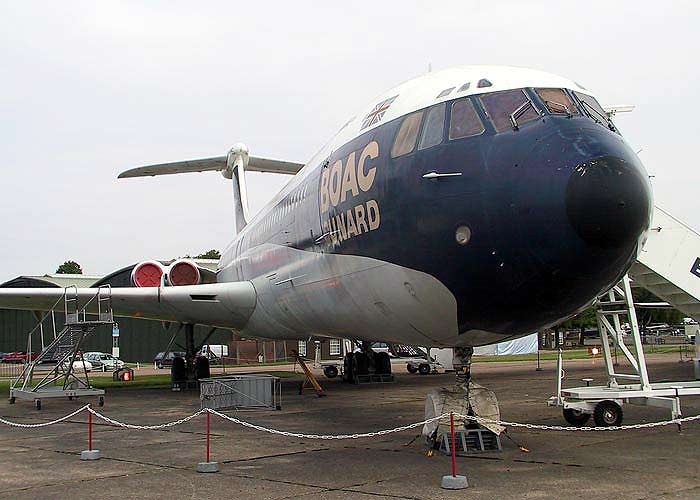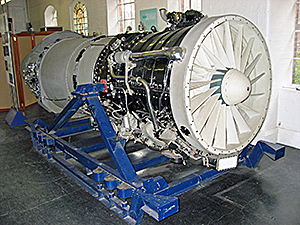

Vickers-Armstrong Super VC10 (G-ASGC) [@ RAF Duxford]
In 1954 Vickers began exploring jet powered derivatives of the highly successful Viscount turboprop airliner and the forthcoming Vanguard. Early designs resembled a Vanguard with a gently swept wing and rear-mounted engines attached to a Caravelle style tail unit. Known as the Vanjet VC10, the design evolved into a three-engined airliner which was planned to be available in two versions: a short to medium range aircraft and a long-range aircraft. Although aircraft closely resembling the short-haul Vanjet were later to appear in the form of the Trident, Boeing 727 and Douglas DC-9 there was little enthusiasm for the early designs. However, BOAC was under political pressure to buy a British jet to offset its planned purchase of Boeing 707s. It therefore showed an interest in a long range aircraft for its Commonwealth routes to South Africa and Australia, but demanded a four-engined type. Accordingly, the design was modified to accommodate the BOAC Specification issued in March 1977 for a four-engined type which was cable of carrying 15,422 kg over 6437 km and could operate from 'hot and high' airfields which had runways too short to take Boeing 707s
 The VC10 prototype G-ARTA, Type
1100,
made its maiden flight on the 29th June 1962 powered by Rolls Royce
Conway engines [photograph - left]. This aircraft originally
had a small wing of 42.72 m span and thrust reversers on all four engines. Certification was achieved on
the 23rd April 1964 and BOAC introduced
the 1101 into service on its London to Lagos route just six days later. Unlike
the prototype, the 1101 (12 built) lacked thrust reversers on the inboard engines but
it introduced graceful curved wing tips which increased the wing area and reduced
cruise drag. The last 1101 was delivered in February 1965. Following on was the
1102 variant which
was ordered by Ghana Airways in 1961. Two of the three ordered aircraft had a
large hydraulically powered side cargo door, 3.55m, on the left side ahead of
the wing. The order for the third aircraft was cancelled. Three similar aircraft were supplied to
British United Airways as the 1103, one of which was from the cancelled Ghana
Airways order. A cancelled Nigerian Airways order resulted in the non-production
of the 1104 variant.
The VC10 prototype G-ARTA, Type
1100,
made its maiden flight on the 29th June 1962 powered by Rolls Royce
Conway engines [photograph - left]. This aircraft originally
had a small wing of 42.72 m span and thrust reversers on all four engines. Certification was achieved on
the 23rd April 1964 and BOAC introduced
the 1101 into service on its London to Lagos route just six days later. Unlike
the prototype, the 1101 (12 built) lacked thrust reversers on the inboard engines but
it introduced graceful curved wing tips which increased the wing area and reduced
cruise drag. The last 1101 was delivered in February 1965. Following on was the
1102 variant which
was ordered by Ghana Airways in 1961. Two of the three ordered aircraft had a
large hydraulically powered side cargo door, 3.55m, on the left side ahead of
the wing. The order for the third aircraft was cancelled. Three similar aircraft were supplied to
British United Airways as the 1103, one of which was from the cancelled Ghana
Airways order. A cancelled Nigerian Airways order resulted in the non-production
of the 1104 variant.
In order to compete with the Boeing 707 and DC-8 a Super VC10 was developed for BOAC. The variant had a longer fuselage, by 3.96m, with a strengthened structure. It also carried an internal fin-mounted fuel tank, thus increasing effective range. More powerful Rolls-Royce Conway Mk31 engines were also fitted, along with thrust reversers on all four engines. Two versions were built, the 1151 (17 built) for BOAC which first flew on the 7th May 1964 and the similar 1154 (5 built) for East African Airways which incorporated a large cargo door and was configured for mixed passenger/cargo operations. Most of the development work for the Super VC10 was done by G-ASGA, which first flew in May 1964. The next four Supers to emerge from the production line were also needed in this program but by February of 1965 both G-ASGC and G-ASGD were loaned to BOAC. These two aircraft went to Shannon and were used for initial crew training. BOAC introduced the Super VC10 on its London-New York route on the 1st April 1965. The Super VC10 was originally planned as a 212-seater but this was reduced to 163 seats at the insistence of BOAC. In fact the annual utilisation of the VC10 and Super VC10 was the highest in the BOAC fleet, its load factors were always significantly higher than the 707 and the actual operating profit was also the highest in BOAC, beating even the 707. BOAC later became British Airways, which operated its last VC10 service on the 29th March 1981, having carried 13 million passengers without accident.
G-ASGC was the third Super VC10 to be built and flew for the first time in January 1965, although its official delivery date is the 27th March 1965. Operated by BOAC and then British Airways until October 1979, G-ASGC flew 54,623 hours and made 16,414 landings. G-ASGC made its final flight from Heathrow to RAF Duxford on the 15th April 1980. The BOAC-Cunard titles on G-ASGC stem from a cooperation scheme between the airline and the shipping company. With the decline in liner travel across the Atlantic Cunard applied for a license to operate scheduled air services from the UK to the USA and ordered two 707s to fly under the Cunard-Eagle Airways flag. After an appeal by BOAC this license was revoked soon after its issue. BOAC then approached Cunard to talk about a joint venture, marrying Cunard's prestige to BOAC's airline experience. From 1962 to 1966 this scheme worked well. In 1966 BOAC warned Cunard that more money was needed to order more and larger aircraft for the North Atlantic. Cunard was unable to provide the capital needed and so BOAC bought Cunard's shares which then ended the joint company.
The 1106 variant was built for the RAF as the VC10 C.1 (14 built) and was based on a Standard VC10 fuselage. However, it was fitted with the Super VC10s wings, engines (with thrust reversers on the outboard only) and fin fuel tank. To aid loading/unloading a large side cargo door was fitted. In addition the following were fitted, an auxiliary power unit in the tail-cone to supply ground electrical power and compressed air for main engine starts, a specially reinforced full area cargo floor, 150 aft facing seats and provision for in-flight refuelling.
In July 1978 British Aerospace was awarded a contract to convert nine aircraft into in-flight refuelling tanker aircraft for the RAF. Five 1101s were to be converted to K.2 standard and four 1154s converted to K.3 standard. This involved bringing the aircraft up to C.1 standard in terms of airframe, engines and avionics. Five extra fuel tanks were fitted in the fuselage, together with a nose in-flight refuelling probe and three refuelling points, one in the lower rear fuselage and one outboard under each wing. Other changes included additional avionics, a closed circuit TV system to monitor receiving aircraft and external lighting. The first aircraft converted, a K.2, first flew on the 22nd June 1982 during the Falklands War. The last of the nine tankers was delivered to 101 Squadron on the 24th September 1985. Another 5 Super VC10s were converted from 1990 to K.4 standard with the first flying on the 30th July 1993. Its clean wing and rear mounted engines help to minimise trailing vortices making it an excellent tanker aircraft. During operations over Afghanistan in 2001 US Navy and Marine fighter crews often preferred the RAF VC10s rather than use nearer USAF tankers. It is expected that VC10s will remain in RAF active service until at least 2009.